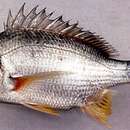Diagnostic Description
provided by Fishbase
This species is distinguished from its congeners by the following set of characteristics: generally deep body in young specimens, becoming slender in larger adults, 2.14-2.70 (mean 2.42) times in SL: D usually XI,11 (very rarely XI,10); scale rows between fifth dorsal-fin spine and lateral line 3.5-4.5 (3.5 often observed in northwestern Kyushu Island and Seto Inland Sea, Japan, southern Korea and Vietnam, and in pre c. 1980 specimens in China, Taiwan and Japan; pers. obs.); scale rows above lateral line 4.5-5.5, scale rows below 10.5-12.5; second anal-fin spine longer than third anal-fin spine [14.6-24.8% (mean 20.6%) of SL], 1.19-1.58 (mean 1.40) in 2AS and 3AS; poredlateral-line scales 44-47 (mean 45.2); the first soft dorsal-fin ray slightly longer than last dorsal-finspine; color of pelvic, anal and caudal fins mostly whitish yellow to strong vivid yellow, except contrasting lower yellow margin on caudal fin; black streaks near anal-fin base on inter-radial membranes between yellow anal-fin rays, even in preserved specimens; no black blotches on inter-radial membranes between dorsal-fin rays; a weak diffuse dark blotch at origin of lateral line (usually covering region of first pored lateral-line scale) continuing as relatively dense blackish shading on upper part of posterior opercle (Ref. 93743).
- Recorder
- Estelita Emily Capuli
Morphology
provided by Fishbase
Dorsal spines (total): 11; Dorsal soft rays (total): 1011; Analspines: 89; Vertebrae: 24
- Recorder
- Estelita Emily Capuli
Trophic Strategy
provided by Fishbase
This species inhabits warm shallow and coastal waters, often entering river mouths and estuaries (Ref. 93743).
- Recorder
- Estelita Emily Capuli
Biology
provided by Fishbase
This species inhabits warm shallow and coastal waters, often entering river mouths and estuaries (Ref. 93743). Used in Chinese medicine (Ref. 12166). It is parasitised by the monogenean Anoplodiscus australis on the fins and body surface (Ref. 124057).
- Recorder
- Crispina B. Binohlan

